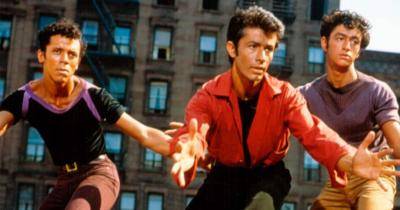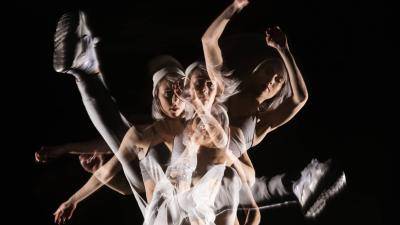Hello all! Keats here, as usual, with some thoughts on our industry. If you’re like me, and have other human friends and social media, you’ve probably seen that there are tons of Broadway musicals coming to theaters near you as film adaptations. You may have also noticed, especially if you have friends who are other dancers/actors/singers, that people have opinions about them -- really, really, intense, polarizing, thought-provoking, meme-inspiring thoughts. Well, I have contemplated this for a while and have churned up how I feel about this -- I’m here to say that we have to judge, observe, and/or bitterly watch (because we weren’t cast in them) movie musicals differently than we watch, judge, and/or bitterly see (because we weren’t cast in them) theatrical musicals. While they are both musicals, their chosen medium of creation changes them completely! In short, because that was probably so far from understandable: Movie musicals and Broadway musicals are two different art forms.
Although the two media are both trying to create a musical show, they go about it in completely different ways. With Broadway film adaptations, a director uses editing in post-production to pick and choose the way the story will be viewed. They can force your eye as an audience member to see much smaller details. They also can use digital effects to make a movie more fantastical or to turn humans into cats. Oh please, if you thought for one second I wasn’t gonna bring that up, you are living delusionally, but more on that later. Movies also aren’t guaranteed to have choreographers in the editing room, a mistake in my opinion. On the other hand, stage productions rely heavily on the suspension of disbelief to convince us that humans can fly, magic is real, and planes are made of towns of folding chairs. Not to speak for the community at large (although I have tons of Facebook posts to back this up), but there are some definite issues in the crossing over of musicals meant for live performances that become film adaptations.
One of the biggest complaints that I have heard is in regards to celebrity casting. I’m actually kind of torn on this one. The theater loyalist in me screams “How dare you not let *insert brilliant actress* belt her face off in the movie version of the role she created?!” But then I remember that we are in the entertainment business and I have to shed my ideological skin and understand that these movies get made to make money so they use the names of stars to sell them. HOWEVER, I do think there is an argument for having a well filmed version of the stage musical.
Honestly, why are we not just making staging changes to produce more incredible full recordings of these live performances!? Are people not into them? I’m into them. I don’t want them to hurt the demand for seeing live entertainment, but for something like The Prom (which is now closed on Broadway and ticket sales wouldn’t be affected), why not just film the stage production? Do we need the hyper realistic set of a high school gym to understand the struggles of our young lesbian ingenue? I certainly don’t think so. Especially since as far as I’m aware none of the cast members in the show are in the movie version; which is a bummer, because I think there is also something cool about using the original ensemble that helped create the show.
Why spend hours on intense choreo if you’re not going to display it?
Also speaking of The Prom, there is a lot of talk about James Cordon playing a gay role, as a straight man. Do I think he will be good in the role? Sure. Would it be nice to have representation of an over the top gay actor played by an actual homosexual… YES! It would for sure keep the movie from playing into stereotypes for laughs and it would be kept much more honest, as it’s played onstage. So, like I said about celebrity casting, I get that there’s always the box office and ticket sales to consider. But, films could maybe use a little improvement when it comes to making authentic casting decisions and staying true to certain characters.
However, in casting’s defense, I couldn’t be happier about how remakes of old movie musicals are being handled. People of color being played by people of color! Thank you, West Side Story; thank you, In the Heights! After rewatching the original West Side Story movie, it is so apparent that the performers playing the lead Sharks are not Puerto Rican. It makes me question whether or not it taints the old film for me. Instead of focusing on that though, for now, I’m gonna continue to praise the new renditions that are righting this wrong and expanding the story to be more inclusive.

Ok, I wanna talk about the Cats movie. Those of you who have stuck with me through the first nine hundred words, this is for you. Now, I will say that I agree, the preview sparked a lot of feelings for me. As a child, I really lived for Cats. I was determined to be the next Jacob Brent and slay as the Magical Mr. Mistoffelees. Although my taste in roles and Broadway musicals has changed since then, I was initially stoked to hear that a new version was being made to inspire people all across the world to get excited about musical theater.
But here is where the suspension of disbelief of theater differs from how it’s used in movies: In the theater, we saw humans dressed as cats and thought, “wow that’s weird, but how else are they supposed to make a musical about cats?” I mean I guess with puppets, because everybody loves puppets, but this was a logical thought as far as logic goes about having a musical about cats. Put the performers in unitards and makeup, give them tails and everyone will, after a brief moment of, “Oh man those are grown humans in unitards” jump on board. Our brains will play along. With movies however, we are becoming much more reliant on photo realism and CGI magic that makes things seem believable in the real world. That being said, I can see how, when presented the option, the director of Cats thought using CGI facial filters for the cat characters would be the best way to make the movie feel the most believable. The production team probably worked really hard on the prototype and it might have looked really amazing. Once that decision was made, they filmed the whole movie with this choice in mind and it was a final decision that there was no going back from. Now that we as a nation of critics have watched this trailer and been less than excited and in some cases downright terrified, it’s too late! They can’t go back and fix this. They made the strong choice to do this CGI face filter and they can’t reshoot the whole movie with stage make-up. I don’t care what studio is making this, they aren’t going to spend the money to do this. But that one singular decision, which until I see the full movie I’m trying not to make an opinion about (at least not a public one), has affected everything about this movie. Clearly the capabilities of film versus stage hugely differentiate them from one another, and it’s up to us as active audience members to form our own opinions on them.
What I think this movie is going to be successful at, that I think is lacking in the live musical, is to bring the audience along on some kind of through-line story. From the trailer, I think they are using the White Cat to represent us, the audience, and introduce us to the world of the Jellicle Ball. I’m excited for that. Using this young, sweet, virginal cat as a device is brilliant. It allows us to feel like “yeah this is weird, but like, she’s figuring it out too.” Kind of like an Alice in Wonderland effect. Once of the best things to come out of all this Cats hype, besides some gut splitting memes, is that the nation is talking about musicals and we now have the opportunity to revisit our favorite Broadway classics and see how we can further improve timeless works of art!
I wasn’t an east-coast child and the first Broadway show I saw, I believe, was Billy Elliot in 2009. Movie musicals were how I got to learn about Oklahoma, West Side Story, Phantom of the Opera, and Singin’ in the Rain. I’m so glad there are more and more musicals on big and small screens for new future performers to become obsessed with and inspired by. And I do have some hopes for them, as far as the dancing is concerned.
Filming and editing dance has since evolved from the original movie musical days, where we saw more overhead shots, longer-length cuts, and sometimes film angles that made the viewer feel like she/he was watching from a proscenium. Back then, dance was used more as a visual storytelling device like it is in stage musicals. As of late, with better editing skills, cool trick camera shots, and basically ever evolving methods of filming, we have started to lose dance as a storytelling technique in film adaptations. Grease Live! especially comes to mind. With so much cutting from character to character, we lose the feel of the whole scene and the dance of these giant musical numbers gets lost. I felt similarly while watching The Greatest Showman. There was some incredible dancing in some scenes that became lost in the shuffle of the quick-cut edits. It wasn’t until I saw the live publicity performances with more wide shots that I could really appreciate the intricacies of the dancing. I mean, why spend hours on intense choreo if you’re not going to display it? So when it comes to storytelling through dance and choreography, I personally feel like I’m able to fully enjoy a dance number in the live performance setting from my proscenium perspective.
Movie musicals and Broadway musicals are two different art forms,
I’ve been thinking a lot about how choreography for film ends up feeling a little second string for me in the priority of most movie musicals and one of the thoughts I had was, “are there even classes that teach choreography for film?” Turns out there are (and at some schools like USC’s Glorya Kaufman School of Dance, it can be a degree focus). I also wonder if it’s that choreographers aren’t the ones also directing the cinematography of the scene? Is it not enough of a shared collaboration between director and choreographer? Is it that the choreographer isn’t in the room to help select the best takes? I, unfortunately, don’t have all the answers but I do hope that with the new West Side Story and Cats movies that, like their stage versions, dance will be used to tell the story. One of my favorite things about West Side is that it follows the idea that when the scene becomes heightened, they sing, and then when the emotions rise in the song and words aren’t enough anymore, they dance. For the new In The Heights movie, I hope they keep the dances that made such awesome transitions in the show. One of my favorite parts of the show was the beautiful dance transitions between scenes. I know we don’t need them in film to help show the passage of time or to disguise a set change, but I hope they don’t lose them entirely. Andy Blankenbuehler’s work is really spectacular and needs to be seen!
So I guess what I’m saying is, although I love movies and the realism they can create, I also hope that dance remains a part of the movie magic and doesn’t just become a semi in-focus blur of humans behind the close-ups of celebrities. Rather, I hope that dance continues to be the final level of emotional expression; That it continues to grow, and through dance, visual storytelling becomes clearer and more engaging.




